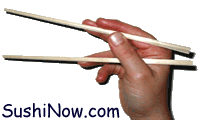This is perfect Nori for rolling all kinds of amazing Maki-Sushi. Large Desiccant Packet included to keep this nori fresh. If you need help rolling sushi you can visit our Sushi Guide
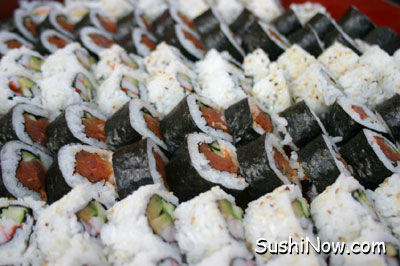 While there are many different varieties of seaweeds used for consumption, Nori is by far the most commonly known and used seaweed on the market. Nori, in more technical terms, is red algae from the Porphyra genus.
While there are many different varieties of seaweeds used for consumption, Nori is by far the most commonly known and used seaweed on the market. Nori, in more technical terms, is red algae from the Porphyra genus.
Japan is the major supplier of Nori, and other types of seaweed, in the world. With a lack of arable and available land to grow crops for its population, Japan has long looked to the see as a source for food. Seaweed in general has been consumed in Japan since 600-800 AD, though at that time it was mostly eaten by Japanese nobility. More universal consumption began between 1600-1800 AD when the shogun of that time ordered fishermen to bring him fish daily. Seaweed grew on the fence of the fish farm, and thus the seaweed farming industry began. Nori sheets themselves were also invented during this time in Edo (former Tokyo) using the same method they use to make Japanese papers.
 The farming of nori, and other types of seaweed, of course, takes place in the sea. Nori grows at a depth of about 25 feet. Farmers use nets to grow the Porphyra plants on while operating and working from boats. It usually takes about 45 days after seeding for the first harvest to occur and then after that multiple harvests can take place about every 10 days. Farmers use heavy machinery to harvest the plants. They are then made into sheets by a process of shredding and rack-drying that is similar to the one used in papermaking. The result is what you often see in stores: a pack of paper thin, dark colored, dried sheets of nori which are approximately 18 x 20 cm and 3 grams in weight.
The farming of nori, and other types of seaweed, of course, takes place in the sea. Nori grows at a depth of about 25 feet. Farmers use nets to grow the Porphyra plants on while operating and working from boats. It usually takes about 45 days after seeding for the first harvest to occur and then after that multiple harvests can take place about every 10 days. Farmers use heavy machinery to harvest the plants. They are then made into sheets by a process of shredding and rack-drying that is similar to the one used in papermaking. The result is what you often see in stores: a pack of paper thin, dark colored, dried sheets of nori which are approximately 18 x 20 cm and 3 grams in weight.
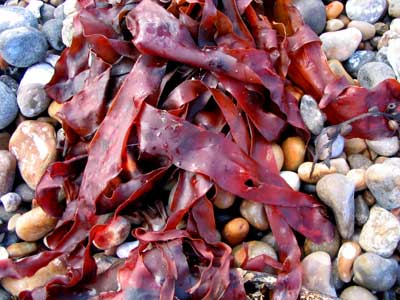 |
Porphyra plants have become so popular that porphyra cultivation is the second largest sub-industry in Japanese aqua farming with a production of 10,326 million nori sheets in 1998. The total production value of nori is about $2 billion per year when valued in US currency.
Nori can be bought either in raw or toasted form. If you buy it in raw form, you will need to toast it before putting it to use. Nori will be crispy and will have a salty taste.
There are many uses for Nori. While kombu seaweed is used most often for soup or nabe dishes and wakame is used for soups and sunomono salads, nori is used in sushi dishes, for rice balls, and as part of noodle and other dishes.
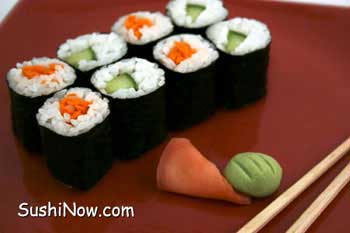 There are different varieties of sushi, and nori is used in many of them. When sushi is wrapped in a nori sheet, it is called “maki” or a “maki roll.” Nigiri-zushi is a popular type of sushi where wasabi and another topping (such as seafood) is laid on top of packed rice and often thinly wrapped with a nori strip. In gunkan-maki nori along with sushi rice is made into a bowl and is filled with seafood or other food items.
There are different varieties of sushi, and nori is used in many of them. When sushi is wrapped in a nori sheet, it is called “maki” or a “maki roll.” Nigiri-zushi is a popular type of sushi where wasabi and another topping (such as seafood) is laid on top of packed rice and often thinly wrapped with a nori strip. In gunkan-maki nori along with sushi rice is made into a bowl and is filled with seafood or other food items.
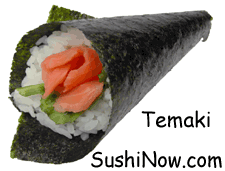 With temaki sushi the nori sheet is formed into the shape of a cone and can be filled with rice, vegetables, and seafood. There are many more types of sushi that use nori. If you have ever eaten sushi at a restaurant that is wrapped in seaweed, you have eaten nori.
With temaki sushi the nori sheet is formed into the shape of a cone and can be filled with rice, vegetables, and seafood. There are many more types of sushi that use nori. If you have ever eaten sushi at a restaurant that is wrapped in seaweed, you have eaten nori.
Onigiri, or rice balls, also use nori sheets. Onigiri is similar to sushi except that it does not use vinegar. It is often in triangle or oval shapes, filled with rice and other ingredients, and wrapped in nori sheets. Nori is also often used in noodle dishes and soup as a garnish and it can even be bought toasted and flavored.
Not only is nori delicious to eat, but according to scientists, it is healthy to eat, too! Nori is high in fiber, protein, minerals, and vitamins. It is high in calcium, zinc, and lignans, which is said to help reduce the risk of cancer. It also contains iodine and is low in fat. However, it is high in sodium, so anyone on a low sodium diet will need to take care when eating much nori.
 Another possible use for our Nori is to feed it to saltwater aquarium fish and algae eaters such as hermit crabs. Because our nori is loaded with minerals and vitamins, marine aquarists started using nori to feed saltwater herbivores. Nori is healthy for both humans and/or your hermit crabs and reef tanks and any algae eaters. Nori contains many Vitamins and Minerals and is also a good source of Protein and Carbohydrates.
Another possible use for our Nori is to feed it to saltwater aquarium fish and algae eaters such as hermit crabs. Because our nori is loaded with minerals and vitamins, marine aquarists started using nori to feed saltwater herbivores. Nori is healthy for both humans and/or your hermit crabs and reef tanks and any algae eaters. Nori contains many Vitamins and Minerals and is also a good source of Protein and Carbohydrates.
Whether you love to eat nori in sushi and rice balls or prefer to feed it to your fish, dried nori will keep very well over long periods of time, providing it is stored wrapped, air tight, and in a cool, dry place. Bon Appétit!
